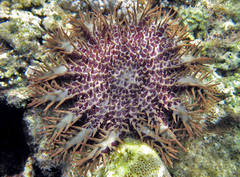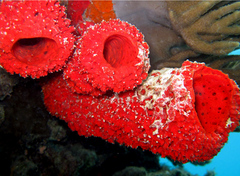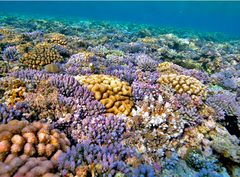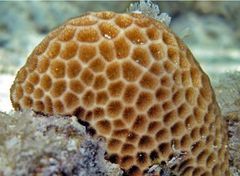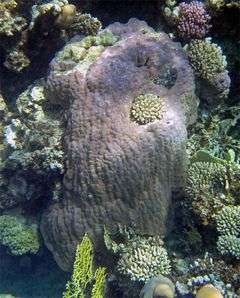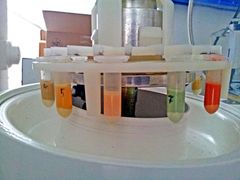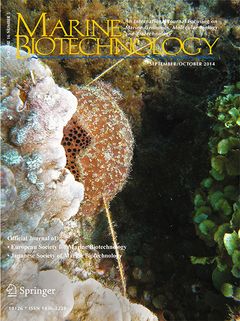Microbial Symbiosis
Leitung

Prof. Dr. Peter Schupp
Research
Forschungsthemen und aktuellen Projekte
At present in English only! * Momentan nur in englischer Sprache verfügbar!
If you are interested in our past and present Bachelor, Master, and PhD research projects - please, visit our 'Students' site
Chemical Ecology
Research investigating the chemical ecology of marine invertebrates aims to understand the ecological function of their secondary metabolites. To gain a better understanding of the ecological roles of secondary metabolites we are assessing possible antimicrobial, antifouling, allelopathic, and signaling and defense functions in selected marine invertebrates. One goal is to combine the chemical ecology research with management-oriented studies to develop new management techniques and strategies to help preserve and manage ecosystems in temperate (e.g. Wadden Sea and north Sea) and tropical locations (e.g. Coral reefs in the Indo-Pacific region).
One focus is the identification of settlings cues for scleractinian coral larvae:
We isolated and identified compounds from crude extracts of crustose coralline algae (CCA, the natural settlement substrate of coral larvae), which either induce or promote settlement of coral larvae (attachment to the substrate) and subsequent metamorphosis to the primary polyp. In addition we isolated and identified from CCA biofilms several bacterial strains, which again induce the settlement of coral larvae. Crude extracts of the isolated bacteria are currently under investigation for identification of the active settlement and metamorphosis principles.
Another project investigates the role of chemical cues in the feeding of the Crown of Thorn Starfish (COTS) Acanthaster planci.
In particular we are interested in the role of possible feeding cues and if these could be exploited for Acanthaster management (attractants in traps).
We have already identified several compounds which act as feeding cues for COTS and continue these studies to find out how these feeding cues correlate with the feeding preferences of COTS for particular scleractinian corals. Study sites currently include Guam and Okinawa in the Pacific.
Coral Research
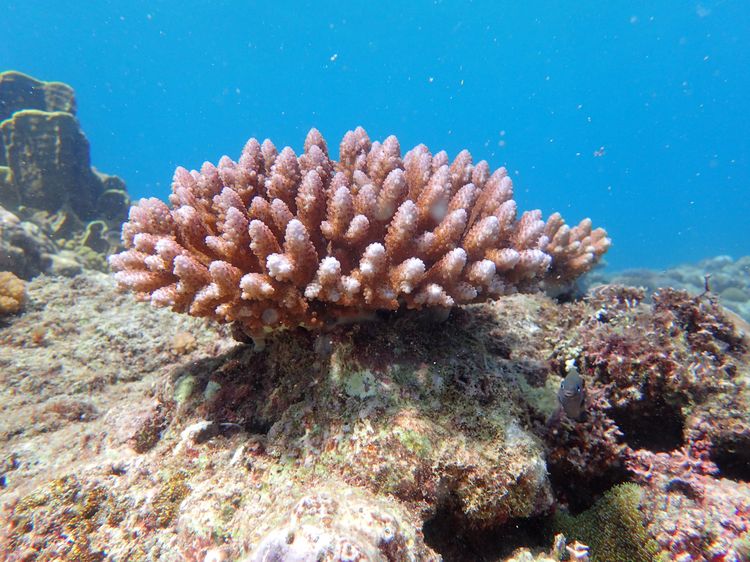
Coral reefs are declining worldwide mainly due to anthropogenic influences. Sexual reproduction is essential for the recolonization and recovery of degraded reefs. However, the early life stages are often neglected by scientists. Our research addresses effects of stressors like elevated temperatures and sedimentation on juvenile corals. We conduct long-term experiments with juvenile corals to assess their adaptive capacity. In order to better understand coral larval settlement, we investigate chemical cues that induce settlement and metamorphosis in coral larvae. Another focus lies on the development of methods to mass produce juvenile corals from gametes. Sexual reproduction of corals has the potential to generate large numbers of juvenile corals for reef restauration and the aquarium trade.
Chemical Ecology of Invasive Species
Biotic invaders are species that establish a new area in which they proliferate, spread and persist to the detriment of the environment. The geographic scale, frequency and number of introduced species increased over the last years due to the expanding transport and commerce. Especially invasive algae are of global concerns since over 400 introductions have been reported worldwide.
The new German deepwater port, Jade-Weser port, in Wilhelmshaven, offers a good opportunity to study impacts of potentially invasive species. The enhanced shipping traffic in the Jade-Weser-Port range may result in the arrival of a variety of exotic species entrained with the ballast water or as fouling species attached to the vessel’s hulk. Identifying future invaders and taking effective steps to prevent their dispersal and establishment constitutes an enormous challenge to both conservation and international commerce.
To ensure a targeted monitoring in the North Sea, potentially invasive species were determined for the Jade-Weser-Port range in collaboration with Prof. Bernd Blasius and his team. A model was developed, which focused on possible invaders through ballast water exchange of large vessels. Possible invaders were ranked regarding their invasive history and geography, resulting in macroalgae species, which could spread in the Jade-Weser Port range. The chemical defense abilities of these potentially invasive species are being compared with non-invasive related species in variable bioassays, which include but are not limited to antifouling, antisettling and antifeeding activities. The aim is the identification of special invasive traits and chemical compounds, which are advantageous for their invasive success.
Marine Natural Products Research
Besides our investigations on the ecological role of marine secondary metabolites we are looking at their pharmacological potential as new drug candidates. Target organisms include invertebrates such as sponges and ascidians from shallow and deep-water environments ranging from 10 to 400 feet. Besides the macroorganisms we also screen bacterial isolates from these holobionts for various biological activities. Screens are conducted in collaboration with groups in Germany, England and the USA and include various antimicrobial, anticancer and antiinfectant assays. Active extracts are followed up with state of the art isolation techniques to identify the active compounds.
Ecotoxicology
Projects investigate the effect of pesticides, herbicides, antifouling paints and other anthropogenic chemicals (e.g. PCBs) on fitness and survival of coral larvae. We are also assessing the potential of different marine invertebrates (soft corals) as biomonitoring organisms for tropical regions.
Many marine sponges contain dense and diverse microbial communities of both ecological and biotechnological importance. These micro-organisms, which can comprise up to 35% of total sponge volume, can be affiliated with Eukarya, Archaea and Bacteria, with at least some of these microbes appearing to be largely specific to sponge hosts. Recent high-throughput sequencing studies on sponge-associated microbial communities from different geographic regions and habitats have expanded our knowledge about the microbial composition of low- and high-microbial-abundance sponges, and divided their communities into: 'core', 'variable', and 'species specific'. In order to achieve such degree of host-specialisation three different transmission scenarios of sponge-specific microorganisms are under consideration: (1) horizontal transmission, (2) vertical transmission, and (3) a combination of both pathways.

Sponge-microbe associations are renowned as a source of bioactive metabolites, with >290 novel compounds isolated from sponges each year. Given that at least some of these metabolites are believed to be made by symbiotic microbes, cultivation of sponge-associated bacteria has been a major focus in the search for novel marine natural products. However, most bacteria from environmental samples, including sponges, have resisted cultivation on artificial growth media. One promising approach to isolating so-called uncultivable microorganisms is the diffusion chamber method. While there are different variations on this approach, the unifying feature is an attempt to cultivate bacteria in situ by allowing interaction with other microorganisms and chemical components within the ambient environment.

This was the first attempt at using diffusion chambers for the isolation of uncultivable bacteria from sponges. The study was conducted by implanting diffusion growth chambers (DGC) in the tissue of Rhabdastrella globostellata reef sponges. We also examine whether abiotic conditions affect the intraspecific microbial communities of sponges. It is hypothesized that sponges could act as microbial refugia to sustain disturbances as part of ecosystem resilience.
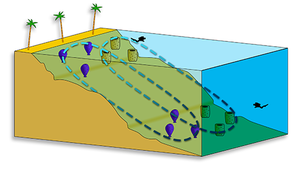

![[Translate to English:]](/f/5/_processed_/3/2/csm_ICBM-Logo-transparent-_91fe1c6774.png)
